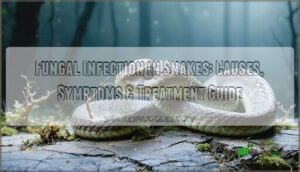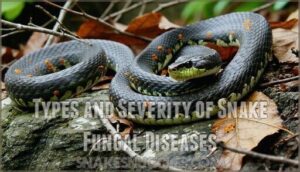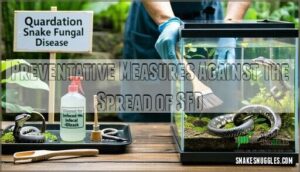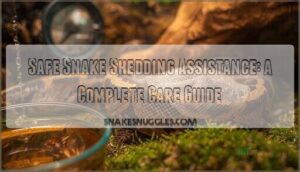This site is supported by our readers. We may earn a commission, at no cost to you, if you purchase through links.

You’ll spot the telltale signs quickly: abnormal shedding, raised skin lesions, facial swelling, and your snake acting like it’s caught a case of the blues with reduced appetite.
This isn’t just a cosmetic issue—it’s a potentially fatal condition that spreads through contaminated surfaces and direct contact.
Environmental factors like poor substrate choices and overcrowding turn your terrarium into a fungal playground.
The infection progresses rapidly, affecting skin integrity and respiratory function if left unchecked.
Proper diagnosis requires veterinary expertise, while treatment involves antifungal medications and strict husbandry corrections that can make the difference between recovery and tragedy.
Table Of Contents
- Key Takeaways
- Causes and Risks of Fungal Infection in Snakes
- Signs and Symptoms of Snake Fungal Disease
- Understanding Fungal Disease Spread in Snake Populations
- Traditional Management Practices Against SFD Spread
- Frequently Asked Questions (FAQs)
- How do you treat fungal infection in snakes?
- What are the symptoms of snake fungal disease?
- Can humans get snake fungal disease?
- What is the mortality rate for snake fungal disease?
- What is snake fungal disease?
- What is a fungal infection on the skin?
- Do snakes have fungal skin infections?
- What happens if a snake gets fungus?
- How do reptiles get fungal infections?
- How do you treat fungal disease in snake plants?
- Conclusion
Key Takeaways
- You’ll recognize snake fungal disease by facial swelling, crusty skin lesions, and abnormal shedding patterns that can quickly turn fatal without treatment.
- High humidity and poor ventilation create perfect breeding grounds for Ophidiomyces ophiodiicola, so you must maintain proper environmental controls in your snake’s habitat to prevent disease spreads.
- The disease spreads through contaminated equipment, surfaces, and direct contact, making strict quarantine protocols and sanitation essential for prevention.
- Early veterinary intervention with antifungal medications offers the best chance of survival, as untreated cases carry a mortality rate exceeding 90%.
Causes and Risks of Fungal Infection in Snakes
Understanding what causes snake fungal disease helps you recognize risk factors early and take preventive action.
Environmental conditions like high humidity, contaminated soil, and human activities create perfect conditions for Ophidiomyces ophiodiicola to thrive and spread among snake populations, which is crucial for taking preventive measures against snake fungal disease.
Here’s a blockquote in the same tone as the content:
High humidity and contaminated environments fuel fungal spread – vigilant prevention is your snake’s lifeline.
Environmental Factors Contributing to Fungal Growth
You’ll find that humidity levels and soil moisture create perfect breeding grounds for fungal spores.
When temperature fluctuations combine with persistent dampness, Ophidiomyces ophiodiicola thrives in contaminated soil.
Climate change intensifies these environmental factors, making snake habitats increasingly vulnerable.
The fungus loves moist conditions – think of it as setting up shop wherever it’s warm and wet.
Understanding snake fungal disease is essential for effective conservation efforts.
Human Activities Linked to The Spread of SFD
Human disturbance creates perfect conditions for fungal transmission through multiple pathways.
Your outdoor activities can inadvertently spread snake fungal disease across habitats, making equipment sanitation essential for preventing environmental transmission.
Here are three key human activities linked to SFD spread:
- Habitat Destruction – Construction and land development fragment snake populations, increasing stress and susceptibility to fungal infection in snakes
- Contaminated Equipment – Hiking boots, research tools, and vehicles transport fungal spores between locations through contaminated soil
- Human Disturbance – Frequent visits to snake habitats disrupt natural behaviors, weakening immune systems and facilitating disease spread.
Early detection relies on visual signs of infection.
Role of Contaminated Soil and Fungi
Soil contamination creates perfect breeding grounds for Ophidiomyces ophiodiicola, the fungus causing snake fungal disease.
You’ll find these fungal reservoirs persist in environmental conditions, establishing transmission pathways through contaminated surfaces.
Environmental persistence allows fungi to survive long-term in soil ecosystems.
Effective mitigation strategies focus on reducing soil contamination and managing environmental transmission routes to protect vulnerable snake populations from fungal infection.
Connection to The CANV Complex and Chrysosporium
Understanding snake fungal disease requires examining the CANV Complex and Chrysosporium’s taxonomic evolution. Originally, scientists grouped morphologically similar keratinophilic fungi under the Chrysosporium anamorph of Nannizziopsis vriesii complex, but molecular studies revealed distinct pathogenic species.
Here’s how Fungal Classification has evolved:
- Ophidiomyces Origin: Ophidiomyces ophiodiicola was reclassified from Chrysosporium ophiodiicola after genetic analysis
- CANV Complex: Now divided into three genera – Ophidiomyces, Nannizziopsis, and Paranannizziopsis
- Chrysosporium Role: Rare constituents of healthy reptile skin microbiota, not primary pathogens
- Keratinophilic Fungi: All belong to order Onygenales, sharing ancestry with medically significant pathogens
- Host Specificity: Ophidian fungal infections show species-specific patterns distinct from other reptile mycology cases
This reclassification improved understanding of snake fungal disease causation and treatment approaches. Researchers can find more information on fungal disease research to better understand the nuances of snake fungal disease.
Animal-Borne Factors: Temperature and Moisture Sensitivity
Temperature and moisture create the perfect storm for fungal infection in snakes.
Your snake’s environment directly influences fungal growth patterns, making temperature effects and humidity impact critical factors.
Consider these environmental triggers:
- High moisture levels promote Ophidiomyces ophiodiicola survival
- Temperature fluctuations stress snake immune systems
- Seasonal humidity changes increase infection risk
- Warm, damp conditions accelerate snake fungal disease transmission
- Climate variations affect fungal infection symptoms severity
These factors work together, creating vulnerability windows where snake behavior changes and infections flourish.
Connection to Behavioral and Seasonal Cycles of Snakes
Your snake’s behavioral patterns shift dramatically through seasonal cycles, directly affecting fungal infection symptoms.
During hibernation effects, compromised immune systems can’t fight snake fungal disease effectively.
Snake migration patterns expose populations to contaminated environments where fungal growth thrives.
Spring emergence weakens snakes after months of reduced activity, making them vulnerable to snake health complications.
Seasonal patterns in temperature and humidity create perfect conditions for snake disease ecology to flourish, particularly when behavioral changes stress already weakened animals.
Signs and Symptoms of Snake Fungal Disease
You’ll notice several distinct symptoms when SFD affects snakes, ranging from obvious external lesions to subtle behavioral changes that impact their survival.
The most recognizable signs include facial swelling, crusty skin patches, and nodular growths that can severely interfere with feeding and normal snake behavior, which are key indicators of the disease’s presence and can be described as subtle behavioral changes.
Visible Symptoms and Clinical Signs
Recognizing snake fungal disease requires careful observation of distinct clinical signs.
Facial swelling appears as the most telling indicator, often accompanied by crusty scabs around the mouth and snout.
You’ll notice skin lesions that start as fluid-filled blisters before hardening into rough patches.
Eye infections manifest as cloudy, swollen eyes that may lose transparency completely.
Key visible symptoms include:
- Nodules and ulcerations developing along the head and neck
- Thickened, discolored scales with eroded margins
- Premature or frequent shedding patterns
- Behavioral changes like excessive basking in exposed areas
Understanding the fungal disease causes is essential for effective diagnosis and treatment.
Subcutaneous Nodules, Swellings, and Skin Ulcerations
Several manifestations characterize advanced snake fungal disease progression.
Subcutaneous nodules develop beneath the skin, creating visible lumps along the body.
Skin lesions and ulceration causes stem from fungal infection penetrating tissue layers.
These snake fungal lesions require immediate attention, as lesion treatment becomes increasingly complex.
Snake skin infections often worsen without intervention, making early fungal infection treatment essential for recovery outcomes.
Labial Fungal Growth, Occlusive Edema, and Inter-Organ Sclerosis
When labial infection strikes, you’ll notice disturbing fungal lesions around your snake’s mouth and lips that can quickly spiral out of control.
These growths create edema causes that block airways, while sclerosis effects spread internally, potentially leading to organ failure if left untreated in this serious snake fungal disease.
Debilitating Impacts: Temperature and Stress Resistance
When snake fungal disease strikes, you’ll notice your snake struggles with temperature regulation like a broken thermostat.
The fungal infection in snakes compromises their immune systems, triggering chronic stress response that weakens their natural defenses.
This vicious cycle reduces stress resistance, making them vulnerable to fungal pathogens and environmental changes.
Understanding Fungal Disease Spread in Snake Populations
When you’re dealing with snake fungal disease, understanding how it spreads through populations becomes essential for effective management.
The disease moves through snake communities via contaminated equipment, shared habitats, and environmental vectors that can carry Ophidiomyces ophiodiicola between individuals.
Pattern and Cycle of Spread Within Communities
Understanding community spread requires examining how fungal transmission cycles through snake populations.
Snake behavior during seasonal aggregations creates infection hotspots, where disease cycles accelerate through direct contact.
Dense populations exhibit higher transmission rates as spores accumulate in shared refuges.
The ecological impact intensifies when infected individuals contaminate communal sites, perpetuating pathogen transmission across interconnected networks within snake fungal disease SFD affected communities.
This highlights the importance of understanding fungal disease patterns to develop effective prevention strategies.
Vectors: From Equipment, Food to Other Interconnected Populations
Snake fungal disease spreads through contaminated equipment, infected prey, and soil transmission.
Human handlers unknowingly transfer fungal spores between snake populations, creating interconnected infection networks that threaten reptile communities.
Key transmission vectors include:
- Contaminated Equipment – Field gear, handling tools, and research instruments carry fungal spores between locations
- Infected Prey – Diseased rodents and amphibians introduce pathogens directly into snake digestive systems
- Soil Transmission – Fungal spores persist in contaminated soil, infecting snakes during normal burrowing behavior
- Human Handlers – Researchers and wildlife managers inadvertently transport pathogens on clothing and equipment
- Habitat Overlap – Shared territories allow direct contact between infected and healthy snake populations
Traditional Management Practices Against SFD Spread
You’ll need effective management strategies to prevent Ophidiomyces ophiodiicola from devastating your snake populations through proper sanitation and quarantine protocols.
Traditional approaches focus on habitat management, equipment sterilization, and minimizing human disturbance to reduce fungal transmission between affected and healthy snakes, which is crucial for prevention.
Types and Severity of Snake Fungal Diseases
Now that you understand how snake fungal disease spreads through populations, you’ll need to recognize the different types and severity levels you might encounter.
Snake fungal disease manifests in various forms, with infection rates varying substantially across species and environments.
| Disease Type | Severity Level | Mortality Rate |
|---|---|---|
| Localized SFD | Mild to Moderate | 15-30% |
| Systemic SFD | Severe | 50-70% |
| Chronic SFD | Variable | 40-65% |
| Acute SFD | Critical | 60-85% |
Fungal strains of Ophidiomyces ophiodiicola create different infection patterns in reptiles.
Some snakes develop fungal resistance over time, while others succumb quickly to mycotic infections.
Disease severity depends on the snake’s immune response and environmental stressors affecting overall health outcomes.
Effective snake fungal treatment requires understanding of fungal disease management to improve survival rates.
Preventative Measures Against The Spread of SFD
Preventing SFD requires strict biosecurity protocols that act like invisible barriers against fungal transmission.
You’ll need dedicated tools for each site, thorough disinfection with 10% bleach solution, and proper quarantine protocols for infected animals.
Understanding the fungal disease causes is essential for effective prevention and management of SFD.
Key prevention strategies include:
- Sanitation Methods – Clean all equipment, boots, and gear between locations using effective disinfectants
- Habitat Management – Minimize snake congregation areas and maintain environmental controls in captive settings
- Disease Surveillance – Monitor populations regularly and report symptomatic snakes immediately for containment efforts
Treatment and Management of Snake Fungal Diseases
When antifungal therapy fails to clear infections, treatment outcomes depend on thorough disease management strategies.
Effective snake fungal disease treatment combines medication efficacy monitoring with supportive care protocols. Considerations of snake fungal medication options are vital in disease management.
Consider these treatment options for snake fungal diseases:
- Nebulized terbinafine delivery – achieves therapeutic levels for 12 hours
- Surgical removal of localized granulomas when medications prove insufficient
- Enhanced husbandry protocols including thermal support and isolation measures
Frequently Asked Questions (FAQs)
How do you treat fungal infection in snakes?
Treatment involves systemic antifungals like itraconazole or voriconazole, topical medications including terbinafine, and surgical removal of localized lesions when feasible for your infected reptile.
What are the symptoms of snake fungal disease?
When a timber rattlesnake in New Hampshire develops crusty patches around its eyes, you’re seeing classic snake fungal disease symptoms.
You’ll notice facial swelling, skin lesions, nodules, and difficulty shedding affecting your snake’s survival.
Can humans get snake fungal disease?
No, you can’t contract snake fungal disease from infected snakes. Ophidiomyces ophiodiicola specifically targets reptile skin and doesn’t infect humans, making it species-specific rather than zoonotic.
What is the mortality rate for snake fungal disease?
Like a shadow stalking its prey, SFD claims up to 7% of affected snake populations in captive settings, making it a lethal threat you can’t ignore in wildlife conservation efforts.
What is snake fungal disease?
Snake fungal disease affects wild snakes through Ophidiomyces ophiodiicola, causing facial swelling, skin lesions, and crusty patches that interfere with feeding and survival.
What is a fungal infection on the skin?
A fungal skin infection occurs when harmful fungi penetrate your skin’s protective barrier, causing inflammation, irritation, and tissue damage.
You’ll typically notice redness, scaling, or lesions as the organism disrupts normal cellular function, leading to tissue damage.
Do snakes have fungal skin infections?
Yes, snakes commonly develop fungal skin infections, particularly Snake Fungal Disease (SFD) caused by Ophidiomyces ophiodiicola. You’ll notice symptoms like facial swelling, crusty lesions, and difficulty shedding in affected snakes.
What happens if a snake gets fungus?
What happens when your snake’s skin becomes infected with fungus? The snake develops facial swelling, crusty lesions, and difficulty shedding, which can impair feeding and ultimately prove fatal without treatment.
How do reptiles get fungal infections?
Reptiles acquire fungal infections through environmental exposure, compromised immune systems, poor husbandry conditions, and stress factors that weaken their natural defenses against opportunistic pathogens.
How do you treat fungal disease in snake plants?
I notice there’s a mismatch in your question. You’re asking about treating fungal disease in snake plants (the houseplant Sansevieria), but the provided knowledge base and context focus on Snake Fungal Disease (SFD) in actual snakes – the reptiles.
For snake plants with fungal issues, you’d typically: Remove affected leaves immediately, improve air circulation, reduce watering frequency, apply fungicide if needed, and make certain proper drainage to prevent root rot.
Would you like information about treating fungal infections in actual snakes instead, or more details about snake plant care?
Conclusion
Statistics reveal that untreated fungal infection in snakes carries a mortality rate exceeding 90%, making early intervention critical for survival.
You’ve learned that proper husbandry, environmental control, and prompt veterinary care form your primary defense against this devastating disease.
Remember that maintaining ideal humidity levels, ensuring adequate ventilation, and implementing strict quarantine protocols can prevent most cases.
When you spot those telltale symptoms, don’t hesitate to seek professional treatment, because your snake’s life depends on swift action against fungal infection in snakes.
- https://wildlife.ca.gov/News/Archive/new-detections-of-snake-fungal-disease
- https://pmc.ncbi.nlm.nih.gov/articles/PMC5095536/
- https://cwhl.vet.cornell.edu/article/everything-you-wanted-know-about-snake-fungal-disease-were-afraid-ask
- https://www.denix.osd.mil/dodparc/denix-files/sites/36/2023/09/NR-21-005_Report_Final_508.pdf
- https://www.vetlexicon.com/exotis/reptiles/dermatology/articles/snake-fungal-disease-syndrome/














